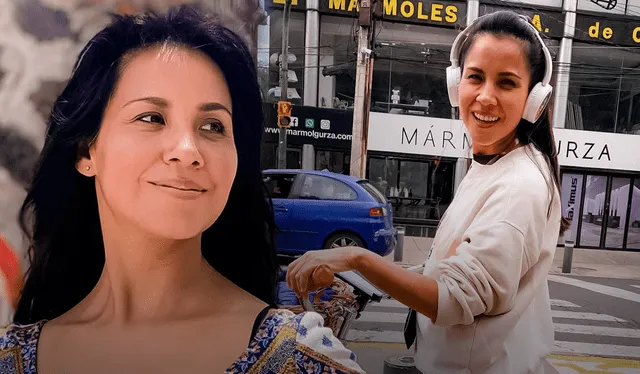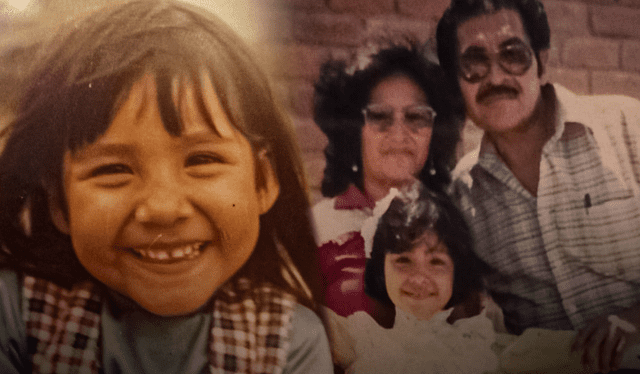Nidia Bermejo replace “little by little” with “step by step”, “try” with “find”. From the age of 23 – now he is 43 – he banishes from his intimate glossary any splash of indecision: “You have to dignify yourself”, she affirms. Worthy, according to the RAE, means deserving of something: perhaps an artistic career that moved from Peru to Mexico in 2019; maybe a spirituality with audiobooks and ayahuasca; maybe a hummingbird-pet. Maybe just the certainty of walking well, under calm. “I put the value that I want on things because they are special to me.”
Calculating the dose of appreciation he learned in the solitude of his childhood: “My brothers were already very big and they didn’t play so much with me anymore. I remember seeing my family watching TV in a separate room and me in the garden crushing little plants, playing little store with paper wrappers. I had many magical moments between the curtains. I remember a lot going around between the curtains”.
And at the age of 6, as if to replicate Calle 13 —one of the groups on his playlist— in the song “Vamo’ a misportarnos”, he took his first theater course. “Raise the curtain, open the curtains!”intones Rene.
Left: Nidia, three years old. Right: Nidia, six years old, together with her parents: Joaquín and Clorinda. Photo: archive by Nidia Bermejo / composition by Álvaro Lozano / La República
—Was it part of the school dynamic or a summer workshop?
—It was a summer workshop at my dad’s work (…). My teacher moved very beautifully and had a very long braid. Pilar, I think her name was (…). She told us to bring old clothes and we put them on, we used hats, gloves, pearls and things like that. She said: “You think theater is wonderful, but this is also theater. You are already characterized to do theater ”. And that opened another thought for me.
Do theater. Do theater. Do theater. The echo after Pilar’s statement lasted a decade and, at 16, although she settled with Medicine or Dentistry the curiosity of those who asked her what career she would follow, she opted for art: “I finished school and joined the TUC (Teatro de la Catholic University)”.
She played Maria Josefa in “The Captive” and Gabriela in “The End Hour”. Curtains and cameras. Two scenarios that, although with different production language, shared a historical theme and, incidentally, familiar to Nidia Bermejo: The terrorism. The beginning and the end of the most painful period in the country.
—How did you prepare for your role in “La hora final”?
—It was incredible because I was with three finalists and I said: “They have to choose me because I am soaked in this” (…). When they chose me I was in the taxi and I was jumping for joy, and the taxi driver was jumping for joy. He didn’t know me, but he told me: “That’s good, that’s good” (…). For me it was a dream to work with Eduardo Mendoza because I consider him one of the best directors we have in Peru. And it was a very nice achievement for the moment I was living because I had to have a character that I know well (…). ANDIt’s a film that I have a lot of affection for, respect.
He also keeps affection and respect for Puno, the cradle city of Joaquin Bermejo Ramos and of Clorinda Pineda Calvo, His parents. “I am fascinated by everything that is there, it seems to me another planet”.
—When was your first visit to Puno?
—I was approximately six years old and I met my grandmother dancing in the street (laughs), because there people dance in the street at carnival times. (…) My grandmother was out of her mind dancing with some dancers, and that is the most beautiful memory I have. From there it began to be magical because there were many artistic stimuli: all the guys dressed up, all the guys danced, all the guys belonged to a music group… My mom asks me where I came from as an actress, and I say: “Oh! ! How do you tell me that if the whole family is an artist?
The last time she traveled to the City of the Sacred Lake was in 2018, when she took on the role of Mama Ocllo. She later decided to hang Felícitas’s apron in “De vuelta al barrio” and migrate to Mexico. This is how she inaugurated her list of removals: in Lima her only record belonged to the Norwegian shred, in Cercado; In the country of Chile, on the other hand, she traveled through the Roma, Condesa, Escandón, Álamos and, today, Coyoacán neighborhood.
“I have traveled a lot, but I had never moved. So the feeling of moving for me was one more trip. And I have the feeling that I am going to return to Peru. So, it is always expanding the territory. I am here, I live here, but I am so connected to Peru that I may return for a project soon.”
—However, does the possibility of returning to live in Peru not have a date? Have you considered any interval?
—No, the pandemic has revealed that to me: that I can no longer make long-term plans. This year I do plan to return to Peru at the end of the year and stay until the first two months of next year (…). I continue to cast for series, for movies, even for advertising.
He also continues nurturing his curriculum, his soul: Monday through Friday, from 5 to 10 pm, and on Saturdays, from 10 am to 3 pm, his schedule is occupied by Actor Improvement Program (PPA) in it Acting Conservatory. “We are doing Tennessee Williams and before that we were doing Chekhov with characters that I have never been given. I mean, I never played a Russian, I never played a gringa from the 50s, never, never (…). And if the world is big, we have to grow by breathing everything it gives us, ”he relates.
—Do you consider any mantra or aphorism as the axis of your life?
—In the Actor Improvement Program they are teaching us to have a mantra every day, so to speak, a mantra, a word, a motto. He always asks us Diego del Rio (artistic director) how you come and how you leave (…). I believe that every day you have to create a goal: today I am going to learn to listen, today I am going to learn to observe, today I am going to learn to love, today I am going to learn to collaborate, today I am going to learn to receive.
—What is the biggest crisis you have experienced so far in Mexico?
—Well, perhaps my crises are insignificant compared to the real crises I see on the news, but I think that living on my savings now could be considered a crisis by some people (…). I thought I was going to have kids at this age, but no, I didn’t. And I feel super good that it wasn’t like that. So I rethink every year: do I really want to have children? Do I really want to get married? Do I really want to meet the standard of expectations that people have for me?

Nidia Bermejo tours Mexico on a bicycle. Photo: Instagram / composition by Álvaro Lozano / La República
And regarding expectations, the artist has exercised a lot: although her greatest professional joy was being the simultaneous image on three banners —theater, film and television— in 2017, her greatest disappointment —later turned into fuel— was receiving noes: “ I got used to receiving so many that I put together all the characters where I had not been selected, I did my homework of watching all the movies or series where I was not selected and I came to a conclusion: I was not ready to take on that project in any sense.
Growth came with patience and was reinforced recently thanks to Pimpal, the bird that sheltered in his apartment for three weeks to heal with flowers, insects and sugar, and then leave: “The hummingbird evolved by leaps and bounds. This little animal, which must have a tiny brain, worked hard, trained, stretched every day to be able to fly.”. Nidia BermejoFor now, it crosses the Mexican sphere and has an always free landing strip: Peru.
Nidia Bermejo: when would you return to Peru and why do you feel much admiration for Puno?

